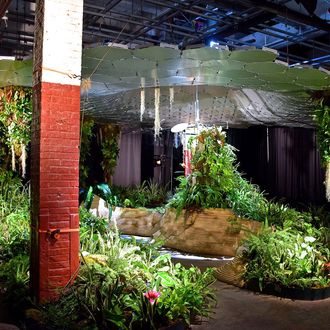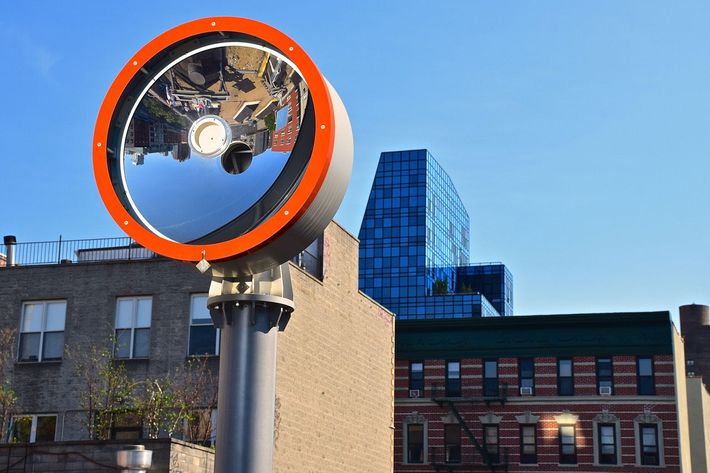
Even more so than the High Line, after which it was named and somewhat inversely inspired, the Lowline is one of the most intriguing urban propositions to come along in some time. Not only is building a mole-man-style park under Delancey Street a daring proposition, but so is the technology of solar arrays behind it that could be adapted to bring natural light deep into office buildings, hospitals, mines, even prisons. If only it didn’t seem like such a pipe dream, bureaucratically as well as technologically.
The de Blasio administration is, at least, helping get over one of those roadblocks. On Wednesday, City Hall gave the project its first official approvals. After an eight-month bidding process, the Economic Development Corporation selected the Lowline as the designated developer for the underground trolley terminal at the base of the Williamsburg Bridge that has been disused for nearly seven decades. No one else submitted a proposal, which made the choice that much easier.
“When they first presented it to me, I thought, That is some crazy, smoking-dope stuff — let’s check it out!” Alicia Glen, the exuberant deputy mayor for housing and economic development, said in an interview Wednesday. “We’re very excited about taking interesting technology, and the way the tech ecosystem is converging around cities, to solve civic problems and objectives.”
City Hall has agreed to grant the project’s creators, James Ramsey and Daniel Barasch, control of the space so long as they can meet certain fundraising and development benchmarks, like proving that their gonzo light-movers can effectively sustain an acre of vegetation underground, year-round. The Lowline Lab, which opened last October in an abandoned section of the Essex Street Market and welcomed 70,000 visitors since, has gone a way toward proving the concept. (Among the first visitors was Deputy Mayor Glen, who said she nearly fell off the roof while inspecting the solar collectors there.)
Still, it will take a lot to persuade the public that a project that will cost $60 million to build and as much as $4 million annually to maintain is worth it. Especially since the city has so far committed no funds for the project, though Glen stressed that public money has not been ruled out.
The project must first get off the ground, or rather under it — the city has given the founders 12 months to raise $10 million, complete a schematic design, and host a handful of sessions for public comments. At some point, the terminal must also be rezoned through the city’s uniform land-use review process. “I never even thought we’d get this far,” Barasch said Tuesday, standing next to a prototype of the solar collectors inside the Lowline Lab. “It’s basically like a giant version of, when you were a kid, using a magnifying glass to focus light to burn leaves and melt toy soldiers.”

Even with all of those hurdles ahead, Wednesday’s agreement is a major milestone, representing the first official approval on the project. It will allow the Lowline’s creators to begin their work of raising funds and sketching plans in earnest. After City Hall’s decision, Manhattan borough president Gale Brewer and local Councilwoman Margaret Chin pledged their support as well.
Ramsey, an architect by profession, first got the idea for the Lowline at his college summer job building satellite optics at NASA’s Goddard Space Flight Center in Maryland. He’s managed to combine this and a few of his other hobbies (fossil hunting, subway exploration) into the Lowline, a test bed of his theories about “liquid light.” Ramsey was absent from Tuesday’s tour because he was just finishing up a trip to Japan, where he was visiting the forests of Yakushima. The place will be familiar to fans of Princess Mononoke, but Ramsey was there because it shares a climate with the one expected to develop in the Lowline. (There is talk of a somewhat similar underground park in Tokyo, and others are being discussed in London, Seoul, Paris, and Moscow, where Ramsey also stopped off on his trip.)
Now that he and Barasch have the city’s support, they will continue to develop the ideas forged at the Lowline Lab, which has also welcomed 2,000 students since its debut. “It’s amazing to come in out of the cold in the middle of winter, and suddenly you’re in the tropics,” Barasch said. “A guy actually walked in once, plucked one of our strawberries, and walked right out. It was like stealing the grapes from Whole Foods.”
The preliminary plan calls for taking the terminal, which is shaped like a wine bottle with the neck broken off, and filling it with a large plaza near the entrance for events, followed by a ramble through a literal urban jungle. Smaller spaces for contemplation and classes will be tucked within the wilderness, all fed by those solar collectors. And just like on the High Line — an obvious referent for the project — some of the old trolley infrastructure, like tracks and platforms, will be preserved. “One of the things that excites us as much as the light is unearthing all these strata of history,” Ramsey said. The team is also trying to figure out a way to install soundproof windows between the trolley space and the tracks of the JMZ, which run alongside each other. (You’ve probably seen the Lowline space, if you’ve ever glanced out the right side of a Brooklyn-bound train as it departs.)
In addition to financial, technical, and logistical hurdles — hello, Con Ed — the project has faced some resistance from the community. A few transit wonks have questioned whether the terminal could be reactivated, perhaps for bus service. Ramsey has produced design studies to show that, at best, only two buses could fit between the narrow columns of the space, and to even get them there would require punching a hole in Delancey Street. “I think it’s pretty clear if something was going to happen with this space by now, it would have,” Glen said. “It has, what we call in the business, ‘negative equity.’ You’d have to pay someone to take it.”
And the usual specter of gentrification has also reared up. Some locals worry that, yes, the Lowline would add much-needed public space to one of the densest neighborhoods in the city, but also drive up rents. Furthermore, in another High Line parallel, there are fears the destination-in-waiting might simply become another overflowing tourist trap inhospitable to locals.
“The Lowline, what they’re offering right now doesn’t seem so bad,” said Victor Papa, president of the Two Bridges Neighborhood Council. “I like the focus on kids, and the eco-enviro focus. It could be an interesting space for not-for-profits. I think they mean what they say, but we have to make sure it doesn’t become a space for the Hollywood set and the cultural elite. This is a community with a lot of low-income families in it.”
The neighborhood is understandably antsy, since the development of the Lowline, which kicked off in 2011, has blossomed at much the same time as Essex Crossing, the nearly 2 million–square–foot redevelopment of all of those parking lots just south of Delancey and the Essex Market buildings to the north. The community had been trying to get the six acres developed since the 1970s, and even once it did there has been widespread ambivalence about the thousands of new residents who will move in.
The project overshadows the Lowline in a very real way — the “park” is directly to the north of the sites, sitting under Delancey Street. Yet Barasch and Ramsey are actually hoping to harness the new buildings to their benefit: The developers have pledged their support to the project, and they may even help pay for it, as well as allow some of the light collectors to be arrayed atop their bulky new towers.
“Anyone who thinks this is about gentrification, it’s not,” Glen said of the Lowline. “What’s happening above ground is happening. This is about bringing an acre of open space to a neighborhood starving for it, and they’re starving for it because there’s nowhere to build it anymore. Except now we’ve found somewhere.”
The local community board gave its conditional approval already, last December, and the co-founders take pains to point out how much they want to involve the community and its needs. On Tuesday, a group of children from a local summer camp were finishing up a design workshop in the Lab by listing things they would like to see eventually fill the Lowline. Among the suggestion on a whiteboard: tree house, water park, soccer, skatepark, AC, laser tag, trampoline, and robot snack machine. “We’re trying to create one of those only–in–New York design experiences,” Barasch said. “Where else would you be sitting in a park underground watching the subway go by?”





























